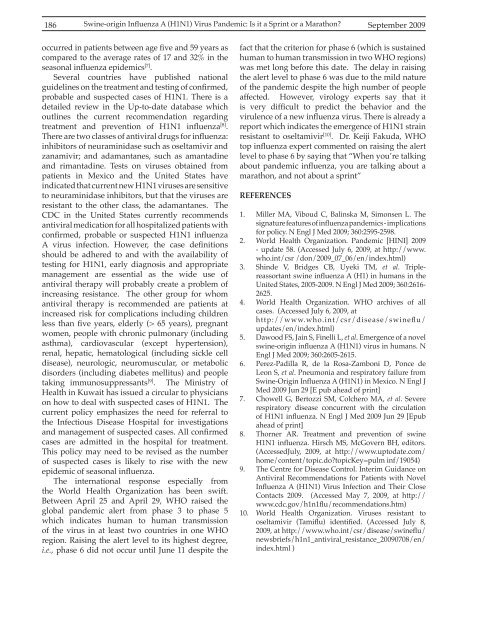Vol 41 # 3 September 2009 - Kma.org.kw
Vol 41 # 3 September 2009 - Kma.org.kw
Vol 41 # 3 September 2009 - Kma.org.kw
You also want an ePaper? Increase the reach of your titles
YUMPU automatically turns print PDFs into web optimized ePapers that Google loves.
186 Swine-origin Influenza A (H1N1) Virus Pandemic: Is it a Sprint or a Marathon<br />
<strong>September</strong> <strong>2009</strong><br />
occurred in patients between age five and 59 years as<br />
compared to the average rates of 17 and 32% in the<br />
seasonal influenza epidemics [7] .<br />
Several countries have published national<br />
guidelines on the treatment and testing of confirmed,<br />
probable and suspected cases of H1N1. There is a<br />
detailed review in the Up-to-date database which<br />
outlines the current recommendation regarding<br />
treatment and prevention of H1N1 influenza [8] .<br />
There are two classes of antiviral drugs for influenza:<br />
inhibitors of neuraminidase such as oseltamivir and<br />
zanamivir; and adamantanes, such as amantadine<br />
and rimantadine. Tests on viruses obtained from<br />
patients in Mexico and the United States have<br />
indicated that current new H1N1 viruses are sensitive<br />
to neuraminidase inhibitors, but that the viruses are<br />
resistant to the other class, the adamantanes. The<br />
CDC in the United States currently recommends<br />
antiviral medication for all hospitalized patients with<br />
confirmed, probable or suspected H1N1 influenza<br />
A virus infection. However, the case definitions<br />
should be adhered to and with the availability of<br />
testing for H1N1, early diagnosis and appropriate<br />
management are essential as the wide use of<br />
antiviral therapy will probably create a problem of<br />
increasing resistance. The other group for whom<br />
antiviral therapy is recommended are patients at<br />
increased risk for complications including children<br />
less than five years, elderly (> 65 years), pregnant<br />
women, people with chronic pulmonary (including<br />
asthma), cardiovascular (except hypertension),<br />
renal, hepatic, hematological (including sickle cell<br />
disease), neurologic, neuromuscular, or metabolic<br />
disorders (including diabetes mellitus) and people<br />
taking immunosuppressants [9] . The Ministry of<br />
Health in Kuwait has issued a circular to physicians<br />
on how to deal with suspected cases of H1N1. The<br />
current policy emphasizes the need for referral to<br />
the Infectious Disease Hospital for investigations<br />
and management of suspected cases. All confirmed<br />
cases are admitted in the hospital for treatment.<br />
This policy may need to be revised as the number<br />
of suspected cases is likely to rise with the new<br />
epidemic of seasonal influenza.<br />
The international response especially from<br />
the World Health Organization has been swift.<br />
Between April 25 and April 29, WHO raised the<br />
global pandemic alert from phase 3 to phase 5<br />
which indicates human to human transmission<br />
of the virus in at least two countries in one WHO<br />
region. Raising the alert level to its highest degree,<br />
i.e., phase 6 did not occur until June 11 despite the<br />
fact that the criterion for phase 6 (which is sustained<br />
human to human transmission in two WHO regions)<br />
was met long before this date. The delay in raising<br />
the alert level to phase 6 was due to the mild nature<br />
of the pandemic despite the high number of people<br />
affected. However, virology experts say that it<br />
is very difficult to predict the behavior and the<br />
virulence of a new influenza virus. There is already a<br />
report which indicates the emergence of H1N1 strain<br />
resistant to oseltamivir [10] . Dr. Keiji Fakuda, WHO<br />
top influenza expert commented on raising the alert<br />
level to phase 6 by saying that “When you’re talking<br />
about pandemic influenza, you are talking about a<br />
marathon, and not about a sprint”<br />
REFERENCES<br />
1. Miller MA, Viboud C, Balinska M, Simonsen L. The<br />
signature features of influenzapandemics-implications<br />
for policy. N Engl J Med <strong>2009</strong>; 360:2595-2598.<br />
2. World Health Organization. Pandemic [HINI] <strong>2009</strong><br />
- update 58. (Accessed July 6, <strong>2009</strong>, at http://www.<br />
who.int/csr /don/<strong>2009</strong>_07_06/en/index.html)<br />
3. Shinde V, Bridges CB, Uyeki TM, et al. Triplereassortant<br />
swine influenza A (H1) in humans in the<br />
United States, 2005-<strong>2009</strong>. N Engl J Med <strong>2009</strong>; 360:2616-<br />
2625.<br />
4. World Health Organization. WHO archives of all<br />
cases. (Accessed July 6, <strong>2009</strong>, at<br />
http://www.who.int/csr/disease/swineflu/<br />
updates/en/index.html)<br />
5. Dawood FS, Jain S, Finelli L, et al. Emergence of a novel<br />
swine-origin influenza A (H1N1) virus in humans. N<br />
Engl J Med <strong>2009</strong>; 360:2605-2615.<br />
6. Perez-Padilla R, de la Rosa-Zamboni D, Ponce de<br />
Leon S, et al. Pneumonia and respiratory failure from<br />
Swine-Origin Influenza A (H1N1) in Mexico. N Engl J<br />
Med <strong>2009</strong> Jun 29 [E pub ahead of print]<br />
7. Chowell G, Bertozzi SM, Colchero MA, et al. Severe<br />
respiratory disease concurrent with the circulation<br />
of H1N1 influenza. N Engl J Med <strong>2009</strong> Jun 29 [Epub<br />
ahead of print]<br />
8. Thorner AR. Treatment and prevention of swine<br />
H1N1 influenza. Hirsch MS, McGovern BH, editors.<br />
(AccessedJuly, <strong>2009</strong>, at http://www.uptodate.com/<br />
home/content/topic.dotopicKey=pulm inf/19054)<br />
9. The Centre for Disease Control. Interim Guidance on<br />
Antiviral Recommendations for Patients with Novel<br />
Influenza A (H1N1) Virus Infection and Their Close<br />
Contacts <strong>2009</strong>. (Accessed May 7, <strong>2009</strong>, at http://<br />
www.cdc.gov/h1n1flu/recommendations.htm)<br />
10. World Health Organization. Viruses resistant to<br />
oseltamivir (Tamiflu) identified. (Accessed July 8,<br />
<strong>2009</strong>, at http://www.who.int/csr/disease/swineflu/<br />
newsbriefs/h1n1_antiviral_resistance_<strong>2009</strong>0708/en/<br />
index.html )
















